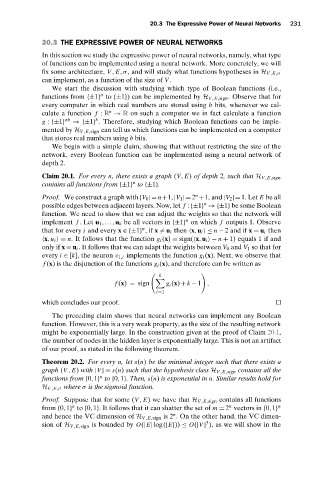Page 249 - Understanding Machine Learning
P. 249
20.3 The Expressive Power of Neural Networks 231
20.3 THE EXPRESSIVE POWER OF NEURAL NETWORKS
In this section we study the expressive power of neural networks, namely, what type
of functions can be implemented using a neural network. More concretely, we will
fix some architecture, V , E,σ, and will study what functions hypotheses in H V ,E,σ
can implement, as a function of the size of V .
We start the discussion with studying which type of Boolean functions (i.e.,
n
functions from {±1} to {±1}) can be implemented by H V ,E,sign . Observe that for
every computer in which real numbers are stored using b bits, whenever we cal-
n
culate a function f : R → R on such a computer we in fact calculate a function
nb b
g : {±1} →{±1} . Therefore, studying which Boolean functions can be imple-
mented by H V ,E,sign can tell us which functions can be implemented on a computer
that stores real numbers using b bits.
We begin with a simple claim, showing that without restricting the size of the
network, every Boolean function can be implemented using a neural network of
depth 2.
Claim 20.1. For every n, there exists a graph (V, E) of depth 2, such that H V ,E,sign
n
contains all functions from {±1} to {±1}.
n
Proof. We construct a graph with |V 0 |= n+1,|V 1 |= 2 +1, and |V 2 |= 1. Let E be all
n
possible edges between adjacent layers. Now, let f : {±1} →{±1} be some Boolean
function. We need to show that we can adjust the weights so that the network will
n
implement f .Let u 1 ,...,u k be all vectors in {±1} on which f outputs 1. Observe
n
that for every i and every x ∈{±1} ,if x = u i then x,u i ≤ n − 2and if x = u i then
x,u i = n. It follows that the function g i (x) = sign( x,u i − n + 1) equals 1 if and
only if x = u i . It follows that we can adapt the weights between V 0 and V 1 so that for
every i ∈ [k], the neuron v 1,i implements the function g i (x). Next, we observe that
f (x) is the disjunction of the functions g i (x), and therefore can be written as
k
f (x) = sign g i (x) + k − 1 ,
i=1
which concludes our proof.
The preceding claim shows that neural networks can implement any Boolean
function. However, this is a very weak property, as the size of the resulting network
might be exponentially large. In the construction given at the proof of Claim 20.1,
the number of nodes in the hidden layer is exponentially large. This is not an artifact
of our proof, as stated in the following theorem.
Theorem 20.2. For every n,let s(n) be the minimal integer such that there exists a
graph (V , E) with |V|= s(n) such that the hypothesis class H V ,E,sign contains all the
n
functions from {0,1} to {0,1}. Then, s(n) is exponential in n. Similar results hold for
H V ,E,σ where σ is the sigmoid function.
Proof. Suppose that for some (V , E) we have that H V,E,sign contains all functions
n n n
from {0,1} to {0,1}. It follows that it can shatter the set of m = 2 vectors in {0,1}
n
and hence the VC dimension of H V ,E,sign is 2 . On the other hand, the VC dimen-
3
sion of H V ,E,sign is bounded by O(|E|log(|E|)) ≤ O(|V | ), as we will show in the

